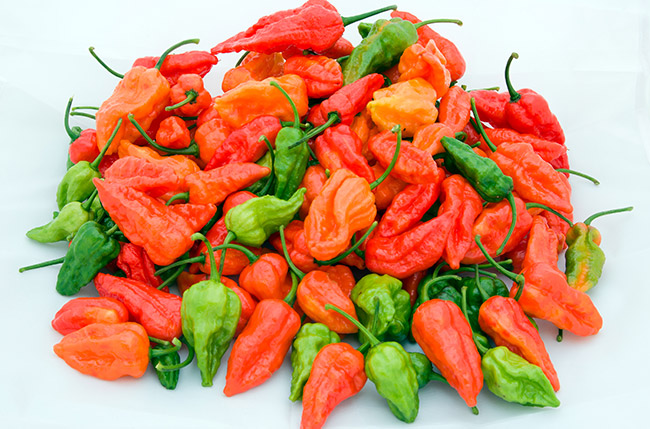
The ghost pepper is originally from India, known there by its Assamese name, Bhut jolokia. Bhut refers to the tribe that is first believed to have cultivated this pepper, the Bhutia people who lived in the valleys of the Assam region of India. The word jolokia means “pepper.” The ghost pepper is also common in the Nagaland region, where it is known as the Naga pepper, or red Naga chile. This name is derived from the people who first settled the Nagaland area. Ghost peppers are found throughout various parts of India, and they by many different names, like the poison chile, and “the king.” The common English name for the chile, the ghost pepper, is regarded as a poor translation. It probably came about due to dialectical and linguistic differences in India and the numerous colloquial names given to the pepper by people in various regions, leading to confusion when translating to English. Nonetheless, the name stuck, and this pepper is ubiquitously known in the Anglosphere as the ghost pepper. The ghost pepper is an interspecies hybrid of the plant species Capsicum chinense and Capsicum frutescens, making this pepper highly unique. The ghost pepper was officially ranked as the hottest pepper in the world in 2007 by the Guinness Book of World Records, but has since been demoted to third place, behind the Trinidad moruga scorpion and the Carolina Reaper. Third place is nothing to scoff at though, at over a million Scoville units, the ghost pepper is absurdly hot. It is so incredibly spicy, that in India, a paste made from ghost peppers is sometimes spread on fences to deter wild elephants from tramping on farm property. Despite the pepper’s insane heat, it has hugely increased in popularity around the world since it gained notoriety as the world’s hottest pepper in 2007. The pepper’s popularity has brought a good deal of income to some of the destitute regions in India where the pepper is cultivated. The pepper is almost always picked and sold in its mature stage, when its skin turns orange or red and its heat is at its peak.
Traditional Indian recipes often call for ghost peppers, but because the pepper was relatively unknown in the rest of the world, almost all Indian recipes outside of India have long used alternatives. Ghost pepper is often used in the preparation of traditional Indian recipes such as curry, tikka masala, and spicier versions of korma. It is often used in soups, creamy sauces, and marinades. The ghost pepper’s flavor is comparable to the habanero, although the ghost pepper is hotter by orders of magnitude. Ghost peppers can be used in any application in which habaneros would be used, especially if more heat is desired. Ghost peppers should always be used in small quantities, and with a large amount of other ingredients to dilute the heat. Citrus can help to tame the heat of the pepper, and it is advisable to use citrus in any recipe in which ghost peppers are used. Ghost peppers can also be calmed by pickling them, and using very small slices of the pickled pepper. Drying and grinding ghost peppers, and using them as a spice can help reduce the heat of the pepper, while still retaining the fiery, sweet flavor.
Fresh ghost peppers will have firm skin and will appear slightly waxy. The surface of the pepper is uneven, and appears wrinkly, but is smooth in texture. They should be kept in the fridge for about a week. When the pepper becomes soft and limp, it is no longer good and should be discarded. It is always important to wash your hands after working with hot peppers, but, a pepper as hot as the ghost pepper should never be handled with bare hands. Your hands, all tools and kitchen surfaces should be thoroughly cleaned immediately after preparing the pepper. When working with fresh ghost peppers, begin by removing the stem by cutting off the cap of the pepper. Sometimes, it is desirable to remove the seeds and membranes of a chile pepper before using it, but with ghost peppers, the seeds must be removed and discarded. A single seed of the ghost pepper rates well over a million Scovilles, and will cause intense pain in the mouth and throat if eaten. To remove them, cut the pepper lengthwise and carefully scrape the seeds out. The pepper should be diced very small to ensure that the heat can be evenly distributed in the dish, without any single bite being overpowering. Always keep these hot peppers out of the reach of children and pets.


 BACK TO PRODUCTS
BACK TO PRODUCTS